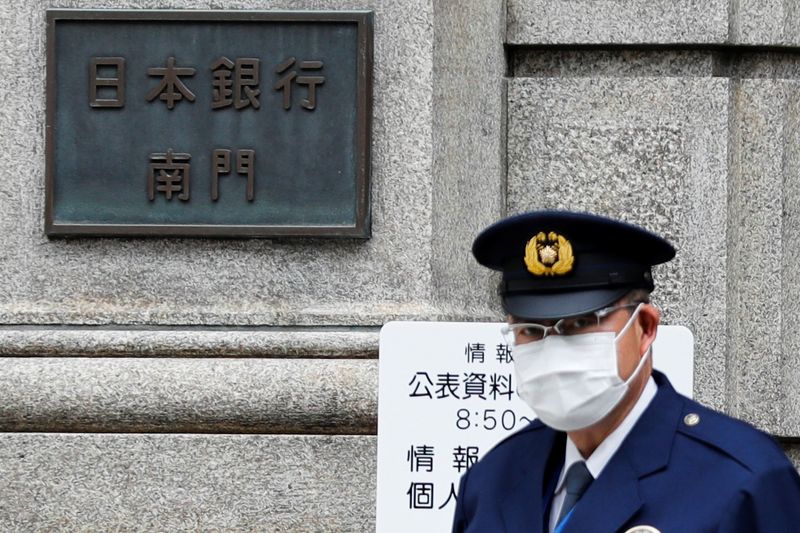By Leika Kihara
TOKYO (Reuters) - The Bank of Japan's push to keep borrowing costs low to cushion the economic blow from the coronavirus is coming at the expense of the country's lenders, which are already buckling under the strain of decades of ultra-low interest rates.
Rising credit costs are hurting financial institutions of all sizes. But the hit has been particularly hard for the smaller regional banks, which make up about half the lending extended in Japan and are already reeling from a shrinking economy and margins that have sunk to a meagre 0.2%.
Their plight highlights the BOJ's policy dilemma - the more it flattens the yield curve, the more it squeezes the very lenders it needs to help revive the economy.
The BOJ's experience underscores the inherent difficulty in managing yield curve control (YCC) at the very time the policy - long a tool in Japan - is gaining more attention from central banks around the world as a way to fight the pandemic-sparked downturn.
It also highlights the BOJ's struggle in figuring out the appropriate shape of the yield curve – one that would help finance the government's huge stimulus package at low cost, without crushing yields of longer-dated debt too much.
"COVID-19 has transformed YCC into a tool to help government issue debt smoothly," said Izuru Kato, chief economist at Totan Research. "The tricky part is that in doing so, the BOJ inflicts huge damage to banks and weakens their ability to lend."
Banks typically earn profits by procuring cheap short-term funds and lending long-term at higher rates. The BOJ's policies have squeezed long-term yields, narrowing margins to the extent of stoking concerns over the viability of some weaker banks.
Japan has over 100 regional banks which focus on lending to companies in the areas they are based in. With close and long relationships with borrowers, they can play a key role in revitalising regional economies.
Over 70% of Japan's regional banks suffered a fall in profit or chalked up losses in the year that ended in March. Their combined bad loans were worth 3.7 trillion yen ($34.5 billion), up 2% from a year ago and nearly four times the profit from core operations.
Their bad loans could spike in coming months as they respond to government requests to boost lending to pandemic-hit firms and as Japan's recession deepens, analysts say.
The BOJ itself warned in April the pandemic, if prolonged, could destabilise Japan's banking system as years of ultra-low rates have prodded lenders to take on more risk.
"It's been tough for us under negative rates, so it would be really, really nice if the BOJ helps steepen the yield curve," Tetsuya Kan, head of Kansai Mirai Bank, a regional lender based in Osaka, western Japan, told Reuters.
For a graphic on central bank balance sheets, click https://graphics.reuters.com/GLOBAL-CENTRALBANKS/010041ZQ4B7/index.html
UP OR DOWN?
The BOJ adopted YCC in 2016, pairing a below-zero short-term rate with a pledge to guide 10-year bond yields around zero.
While YCC aimed to spur growth by capping borrowing costs, it also intended to ensure a sliver of a lending margin for banks by preventing longer-term yields from sliding into negative territory.
Mindful of the rising cost of prolonged easing, the BOJ sought to raise rates when the economy was improving in 2018.
The attempt failed, and now leaves the central bank having to choose between supporting borrowers and banks - and forced to choose the former to boost the economy.
A recent rise in super-long yields to a more than one-month high has drawn renewed market attention on the BOJ.
While the BOJ has kept a tight grip on 10-year yields, it has allowed yields for longer-dated bonds to move more flexibly.
BOJ Governor Haruhiko Kuroda said earlier this month there was no change to his view that excessive falls in super-long yields were undesirable as they hurt bank profits.
But he also said the BOJ wants a "stably low" yield curve, causing some confusion in the market as to whether the bank wanted to push super-long yields up, or down.
Masahiko Loo, portfolio manager at AllianceBernstein (NYSE:AB) in Tokyo, said the BOJ was trying to find a "sweet spot" where the curve isn't too steep - but not entirely flat. "I think they're still looking for the balance here," he said.
Investors will get some clues on the BOJ's thinking on Tuesday, when it announces its bond-buying plans for July.
With the government planning to ramp up bond sales by more than 30% from July to fund a huge stimulus package, some investors expect the central bank to increase purchases.
An increase in buying of super-long bonds would reverse more than three years of slow tapering the BOJ had undertaken to ease the strain of a flat yield curve on financial institutions.
"The BOJ probably isn't ruling out an increase" in purchases of super-long bonds with the economy in bad shape, said a source familiar with its thinking, a view echoed by another source.
"In times like this, it's important to keep borrowing costs low and stable," the source said.

($1 = 107.1300 yen)